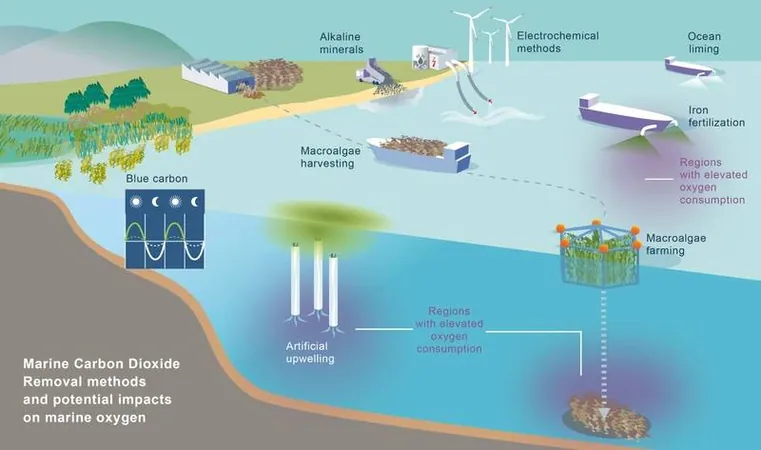
Ancient Predator Uncovered: Meet the 506-Million-Year-Old Mosura fentoni!
2025-05-13
Author: Nur
A Stunning Discovery in Canada's Burgess Shale
In an astonishing revelation, paleontologists from the Manitoba Museum and the Royal Ontario Museum (ROM) have unearthed a 506-million-year-old predator, now named Mosura fentoni, from the Burgess Shale in Canada. This remarkable finding is detailed in a groundbreaking paper published in the Royal Society Open Science.
Meet the Sea-Moth: A Predator Unlike Any Other
At just the size of an index finger, Mosura fentoni boasted striking features: three eyes, spiny jointed claws, a circular mouth filled with teeth, and swimming flaps along its body. As a member of the extinct radiodonts, it shares its ancient sea habitat with the more famous, meter-long predator, Anomalocaris canadensis. Yet, Mosura sets itself apart with its unique abdomen-like region made up of multiple segments, a feature never seen before in its relatives.
A Fascinating Evolutionary Adaptation
Joe Moysiuk, Curator of Paleontology at the Manitoba Museum and the study's leader, remarks, "Mosura has 16 tightly packed segments lined with gills at its rear end, demonstrating an evolutionary convergence with modern creatures like horseshoe crabs and insects. This adaptation might hint at its specific habitat preferences or breathing efficiency needs."
From Depths of Prehistory to Modern Curiosity
Affectionately nicknamed the "sea-moth" due to its resemblance to moths, Mosura's scientific name pays homage to the iconic Japanese kaiju, Mothra. However, its lineage traces back into a much earlier branch of the arthropod family tree, connecting it distantly to not only moths but also spiders and crabs.
"Radiodonts were among the first arthropods, thus providing crucial insights into the ancestral traits of this entire group," explains study co-author Jean-Bernard Caron from ROM. "Mosura highlights the astonishing diversity and adaptability of these early creatures, paralleling developments in their modern descendants."
Revealing the Secrets of Mosura's Internal Anatomy
Remarkably, many Mosura fossils exhibit details of internal anatomy, unveiling aspects of its nervous, circulatory, and digestive systems. Caron emphasizes, "Few fossil sites globally provide such depth into soft anatomical features. We can observe nerve bundles akin to those seen in living arthropods, making this discovery all the more impressive."
Ancient Circulatory Systems Uncovered
Instead of a traditional circulatory system, Mosura possessed an "open" system, where its heart directed blood into large body cavities called lacunae. These lacunae, preserved in the fossils, allow scientists to better understand similar circulatory features in other ancient fossils.
A Treasure Trove of Fossils
Of the 61 Mosura fossils known, nearly all were collected by the ROM between 1975 and 2022, primarily from the Raymond Quarry in Yoho National Park, British Columbia. Some were also found in newly explored regions around Marble Canyon, offering additional insights into this extensive ecosystem. Notably, one specimen had been kept in the collections since the time of Charles Walcott, the original discoverer of the Burgess Shale.
A Window into Earth's Forgotten History
The Burgess Shale fossil sites, renowned for their rich history, are protected within Yoho and Kootenay National Parks, managed by Parks Canada. Designated a UNESCO World Heritage Site in 1980, these sites continue to educate the public about a pivotal time in Earth's history through award-winning guided hikes.
As part of the ongoing research and exhibitions, visitors can see several radiodont fossils at the ROM in Toronto, with Mosura making its debut display at the Manitoba Museum later this year. As Moysiuk poignantly states, "Museum collections, old and new, are a bottomless treasure trove of information about the past."



 Brasil (PT)
Brasil (PT)
 Canada (EN)
Canada (EN)
 Chile (ES)
Chile (ES)
 Česko (CS)
Česko (CS)
 대한민국 (KO)
대한민국 (KO)
 España (ES)
España (ES)
 France (FR)
France (FR)
 Hong Kong (EN)
Hong Kong (EN)
 Italia (IT)
Italia (IT)
 日本 (JA)
日本 (JA)
 Magyarország (HU)
Magyarország (HU)
 Norge (NO)
Norge (NO)
 Polska (PL)
Polska (PL)
 Schweiz (DE)
Schweiz (DE)
 Singapore (EN)
Singapore (EN)
 Sverige (SV)
Sverige (SV)
 Suomi (FI)
Suomi (FI)
 Türkiye (TR)
Türkiye (TR)
 الإمارات العربية المتحدة (AR)
الإمارات العربية المتحدة (AR)